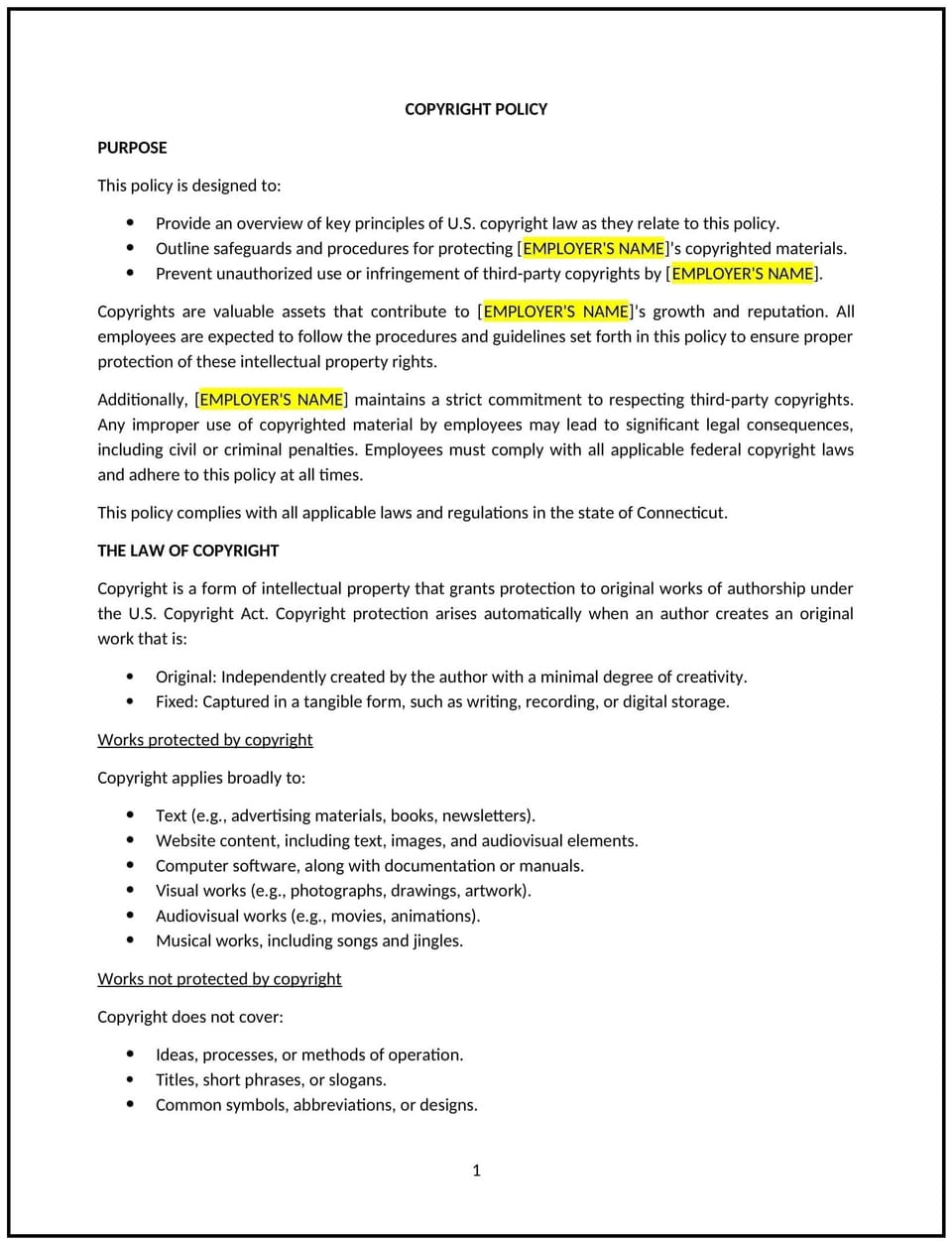Copyright policy (Connecticut): Free template

Copyright policy (Connecticut)
A copyright policy helps Connecticut businesses manage and protect their intellectual property by outlining the rules for using, creating, and sharing copyrighted materials. This policy defines what constitutes copyrighted content, the company’s stance on respecting third-party copyrights, and procedures for handling potential infringement, ensuring compliance with both state and federal copyright laws.
By implementing this policy, businesses can protect their intellectual property, avoid legal risks, and foster a culture of respect for others' works.
How to use this copyright policy (Connecticut)
- Define copyrighted materials: Clearly specify what constitutes copyrighted materials, such as text, images, software, music, and other creative works that are protected by copyright laws.
- Establish usage guidelines: Outline how employees can use copyrighted materials, including obtaining proper licenses or permissions to avoid infringement.
- Address creation of copyrighted works: Specify who owns the rights to content created by employees during their employment, and how the company handles such works.
- Handle third-party content: Set guidelines for using third-party copyrighted content, including the requirement to secure proper licensing or permissions.
- Respond to infringement: Define the process for handling alleged copyright infringement, including steps to investigate, resolve, and take corrective action if necessary.
- Educate employees: Offer training or resources to employees on copyright laws, fair use, and how to avoid infringing on others' intellectual property.
Benefits of using this copyright policy (Connecticut)
This policy offers several benefits for Connecticut businesses:
- Protects intellectual property: Safeguards the company’s creative works, such as branding, content, and inventions, from unauthorized use or infringement.
- Reduces legal risks: Helps ensure compliance with Connecticut and federal copyright laws, reducing the risk of costly legal disputes or fines.
- Fosters a culture of respect: Encourages employees to respect the copyrights of others, helping prevent inadvertent infringement.
- Supports business growth: Ensures that creative works produced by the company are protected, allowing for the full exploitation of intellectual property rights.
- Improves brand integrity: Protects the company’s brand and ensures that proprietary content is used only in ways that align with the business’s goals.
Tips for using this copyright policy (Connecticut)
- Communicate clearly: Ensure that employees understand the importance of respecting copyright laws and the company’s guidelines for using and creating copyrighted content.
- Provide resources: Offer access to tools or legal resources to help employees navigate copyright law and obtain proper permissions for using third-party content.
- Monitor usage: Regularly review how copyrighted materials are being used within the company to ensure compliance with the policy.
- Address violations promptly: Investigate any potential infringements swiftly and take corrective action when necessary, whether it involves ceasing use, obtaining proper licenses, or revising content.
- Review periodically: Update the policy as needed to reflect changes in copyright laws, business practices, or the company’s intellectual property strategy.
Q: How does this policy benefit my business?
A: The policy helps protect the company’s intellectual property by clearly defining guidelines for using and managing copyrighted content, reducing legal risks, and ensuring compliance with copyright laws. It fosters respect for third-party intellectual property, mitigating the risk of copyright infringement claims.
Q: What steps should I take to implement this policy effectively?
A: To implement the policy, communicate it clearly to all employees, particularly those involved in content creation and usage. Provide training on how to navigate copyright laws, obtain permissions, and ensure that both company-owned and third-party content is handled appropriately.
Q: How should I address a situation where an employee uses copyrighted content without permission?
A: If a violation occurs, investigate promptly and determine whether the content was used without proper licensing or permission. Corrective actions should include obtaining proper licensing, removing or replacing the infringing content, and potentially offering training or disciplinary measures for repeated violations.
Q: What happens if the company is accused of copyright infringement?
A: In the event of an accusation, the company should immediately assess the situation, address any infringement claims, and take corrective action. This may include removing the infringing content, resolving the dispute, and ensuring compliance moving forward.
Q: How often should this policy be reviewed and updated?
A: The policy should be reviewed regularly, at least annually, or whenever there are updates to Connecticut laws, federal copyright regulations, or changes in business practices that affect how intellectual property is used or protected.
This article contains general legal information and does not contain legal advice. Cobrief is not a law firm or a substitute for an attorney or law firm. The law is complex and changes often. For legal advice, please ask a lawyer.


